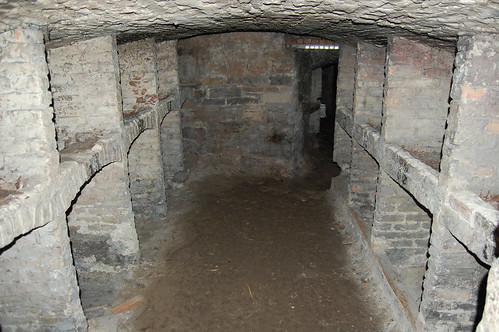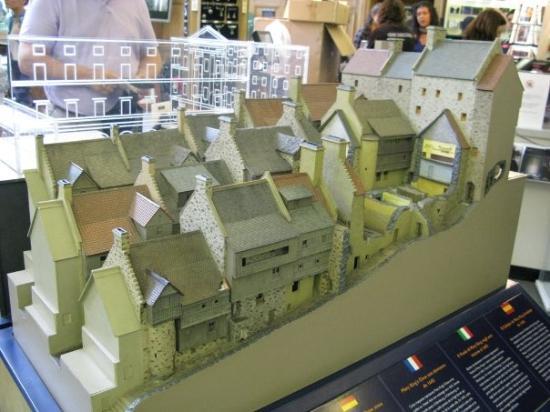The Edinburgh Vaults or South Bridge Vaults are situated in tunnels built in the 18th century underneath one of the arches of the South Bridge in Edinburgh, Scotland, which was completed in 1788. For around 30 years, the vaults were used to house taverns, cobblers and other tradesmen, and as storage space for illicit material, reportedly including the bodies of people killed by serial killers Burke and Hare for medical experiments.
As the conditions in the vaults deteriorated, mainly because of damp and poor air quality, the businesses left and the very poorest of Edinburgh's citizens moved in, though by around 1820, even they are believed to have left too. That people had lived there was only discovered in 1985 during an excavation, when middens were found containing toys, medicine bottles, plates, and other signs of human habitation.
Background
Edinburgh was a growing community in the late 1700s and two bridges were built to facilitate the expansion, North Bridge and South Bridge, known locally as 'The Bridges'. The South Bridge, built to span the Cowgate gorge between High Street and the growing University of Edinburgh on the Southside, was first proposed in 1775, although work did not begin until August 1785.[2]
Edinburgh's South Bridge should be regarded as more than a simple crossing from Old Town to Southside. It was, in fact, Edinburgh's first purpose built shopping street, and as such as much space as possible was utilised. The bridge itself is a nineteen arch viaduct, although only one arch is visible today, the 'Cowgate arch.' The remaining eighteen arches were enclosed behind tenement buildings built to allow the area to serve as a commercial district. The hidden arches of the bridge were then given extra floors to allow their use for industry. In total there are approximately 120 rooms or 'vaults' beneath the surface of the South Bridge, ranging in size from two metres squared to forty metres squared. South Bridge officially opened for business on 1 March 1788.
Edinburgh Vaults Room 1
The vault rooms, used as storage space and workshops for the South Bridge businesses, operated as intended for a relatively short space of time. Construction of the bridge had been rushed and the surface was never sealed against water. The vaults began to flood. Abandonment of the vaults began as early as 1795. With the vaults being gradually abandoned by the businesses on the bridge, the empty rooms were adopted and adapted by new users. As the industrial revolution took hold of Britain, the Cowgate area had developed into Edinburgh's slum. Slum dwellers took over the vaults and they became a renowned red light district with countless brothels and pubs operating within the abandoned complex. The vaults also served as additional slum housing for the city’s poor. Living conditions were appalling. The rooms were cramped, dark and damp. There was no sunlight, poorly circulated air, no running water, and no sanitation. Many rooms housed families of more than ten people. Crimes, including robbery and murder, soon plagued the Vaults. Burke and Hare, the infamous serial killers who sold corpses to medical schools, are rumoured to have hunted for victims in the Edinburgh Vaults.
 One of the vaults used as storage space
One of the vaults used as storage spaceIt is not known when the vaults complex was closed down, with some suggesting as early as c.1835 and others as late as c.1875. Written records regarding the vaults during their slum use are virtually non-existent. All that is known is that at some point tons of rubble were dumped into the vaults making them inaccessible.
The vaults were rediscovered by former Scottish rugby internationalist, Norrie Rowan, after he found a tunnel leading to them in the 1980s. From this tunnel he helped Romanian rugby player Christian Raducanu escape the Romanian secret police and seek political asylum weeks before the Romanian uprising of 1989.
The vaults were excavated by Norrie Rowan and his son Norman Rowan in the 1990s. Hundreds of tonnes of rubble were removed by hand and several interesting artifacts were dicovered including thousands of oyster shells, which were part of the staple diet of the Edinburgh working class.
The vaults on the North Side of the Cowgate arch form a series of tunnels and vaults that make up Mercat Tours and a venue called Marlin's Wynd. The vaults on the South side of the Cowgate arch form a magnificent venue called The Caves. Also the vaults here are used for tours by a company called City of the Dead
Niddry vaults 2
Since then, the Vaults have become a popular tourist destination for professional and amateur ghost-busters, who come to explore their gloomy, candle-lit corridors in the hope of meeting a spirit.
Reported spectral tenants include the cantankerous "Mr. Boots", who nudges tourists, can be heard swearing, and tails tour groups while clomping on the stone floor. Then there’s young "Jack", a boy who giggles as he runs about the dark rooms. Tours to the areas featuring these ghosts are run by Mercat Tours. City of the Dead runs other underground tours.
The frequent reports of paranormal activity and ghost sightings resulted in the UK paranormal entertainment show, Most Haunted, to investigate the vaults in both a 24 hour investigation and for a Most Haunted Live show on Halloween 2006. The television show Ghost Adventures investigated the vaults and claimed to have numerous encounters with spirits there.
In 2001, Professor Richard Wiseman of the University of Hertfordshire invited subjects to spend time in the Edinburgh Vaults. His study concluded that people who believed in ghosts reported more supernatural experiences than disbelievers, that participants consistently reported unusual sensations in areas they were told were haunted, and that there was an increased report of incidents in Vault rooms with a decidedly more sinister visual appearance or stronger cold air flow. Professor Wiseman’s study suggests that visitors may help create the haunted experience they expect to find in the Vaults.
However in 2009 a BBC TV production team filming a one-off TV special featuring Joe Swash recorded unexplained voices in the vaults during an overnight sleepover by Swash. One voice appeared to be that of a Catholic priest reciting the Last Rites. Swash was the only person in the vaults and did not hear the voices himself at the time of recording, despite the sounds being audible on his own microphone. The voices continued to be heard on the recording for some 20 minutes before abruptly ceasing after what appears to be the sound of children yelling. BBC sound engineers initially thought the sounds may be explained by voices drifting into the tunnels from nightclubs nearby but this was found to be incorrect and no other logical explantion could be found. The recordings were broadcast as part of the finished program Joe Swash Believes in Ghosts on BBC Three in January 2010.
Links
Here's a link Mary King's Close subterranean tunnels & chambers
[URL="http://www.davidicke.com/forum/showthread.php?p=1058727657#post1058727657"]http://www.davidicke.com/forum/showthread.php?p=1058727657#post1058727657[/URL]















